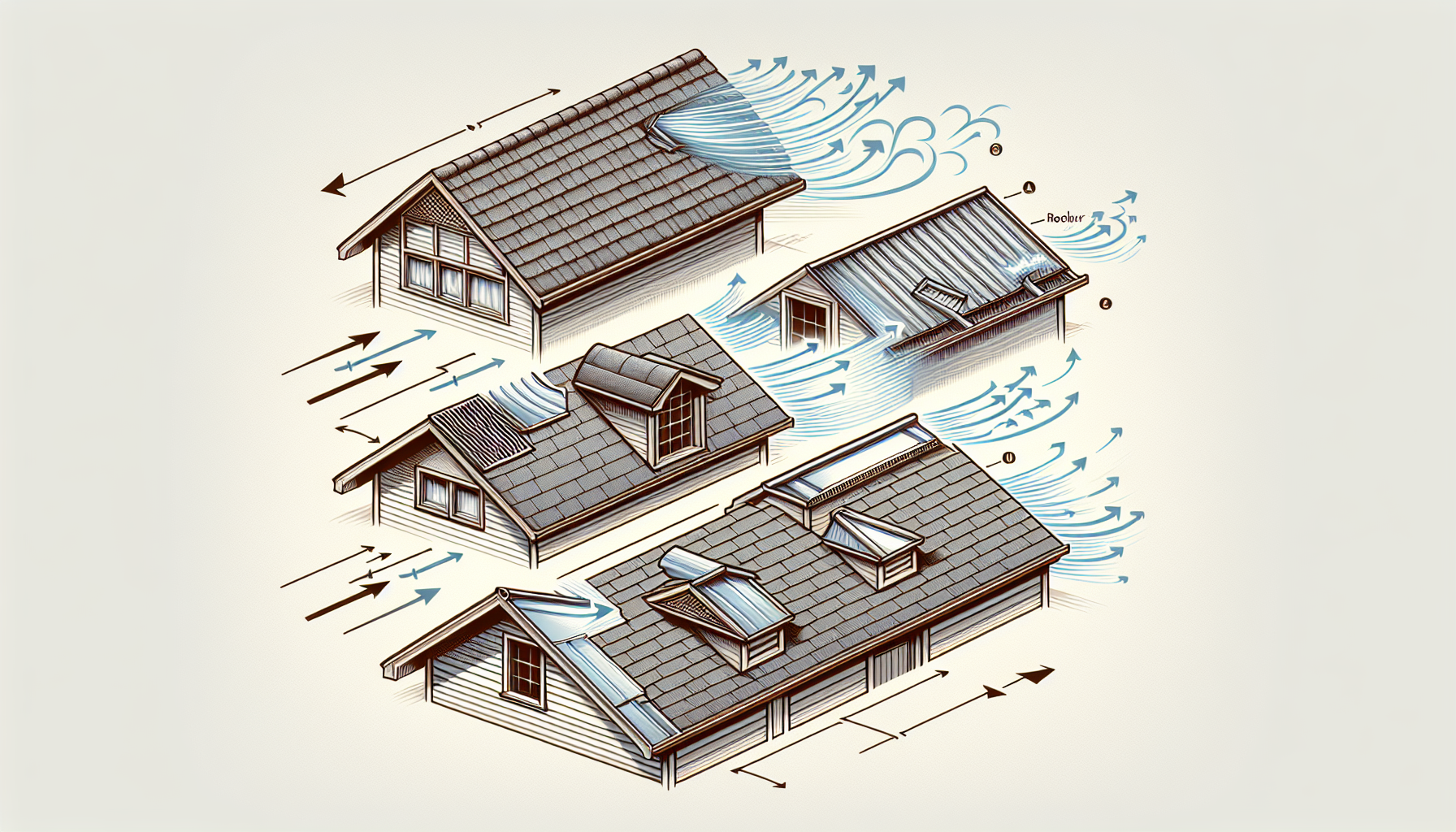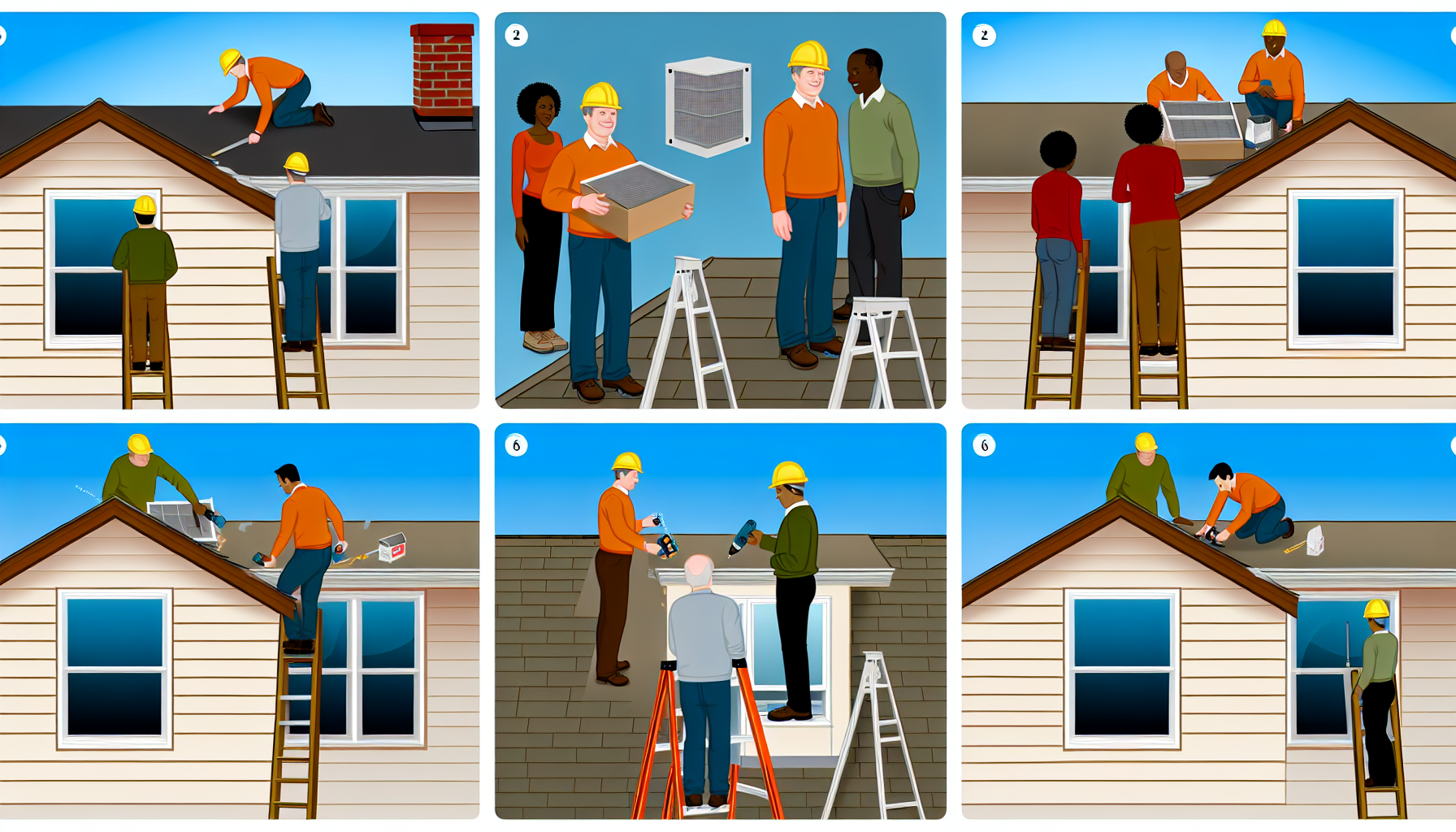Expert Roof Vent Installation Near Me: Your Guide to Safe and Efficient Attic Ventilation
Struggling with attic ventilation? This comprehensive guide cuts straight to the chase: find expert “roof vent installation near me” services, understand the options available, and ensure a safe and efficient installation tailored to your home’s needs.
Key Takeaways
Effective attic ventilation is essential for home energy efficiency, air quality, and the longevity of roof materials, requiring awareness of vent options, sizing, and regulations.
The roof vent installation process involves meticulous planning, including pre-inspection, professional installation, and post-install checks to ensure optimal performance and prevent future issues.
Choosing a qualified roofing contractor is critical, as their expertise, proper insurance, and offering of installation warranties can significantly influence the long-term success of roof vent installation.
Exploring Roof Vent Options for Effective Attic Ventilation
Embarking on the path to efficient attic ventilation starts with choosing an appropriate roof vent for your needs. With a wide range of roof vents available, understanding how each type differs is crucial in order to match the selected vent both with the specific design of your roof and the ventilation requirements of your home.
In our exploration, we will thoroughly examine all these considerations.
Types of Roof Vents to Consider
There are several types of roof vents, each offering distinct advantages. Among these varieties are:
Ridge Vents
Off-Ridge Vents
Box Vents
Solar-Powered Attic Vents
Roof Turbines
Hard-Wired Powered Attic Vents
Soffit vents serve the essential function of permitting fresh air to enter the attic, thereby improving airflow throughout. Conversely, ridge vents prove effective in releasing hot air from the attic space, which helps reduce heat build-up and improves overall energy efficiency.
Gable vents play an important role in enhancing ventilation for roofs by prolonging the life of roofing components and protecting against damage caused by moisture within both the attic space and roof structure.
Matching Vents to Your Roof Design
Your roof’s design greatly influences the choice of appropriate roof vents. Specific types of vents are better matched to certain roof shapes or inclines, for instance.
Ridge vents pair well with particular styles or slopes of roofs.
Box vents, Keepa vents, and breather vents work best on flat-roofed structures.
For steeper sloped roofs, Aura Gravity Vents and Pop Vents serve as suitable exhaust mechanisms while Soffit Vents can be utilized for air intake.
When it comes to metal roofing systems, ridge venting solutions emerge as an excellent choice.
It is crucial that your selection not only caters to preventing moisture-related damage but also ensures efficient ventilation in relation to the specific characteristics inherent in your roofing material.
Ventilation Requirements for Your Home
Ensuring adequate ventilation within a home is crucial for several reasons. These include the elimination of large particles, dust, and airborne contaminants, which enhances the quality of indoor air and diminishes the likelihood of respiratory ailments. It aids in managing moisture concentrations to inhibit the growth of mold and mildew while also maintaining comfortable levels of temperature and humidity.
To facilitate proper intake and exhaust venting areas in a house, one must compute the net free area (NFA) required for each type of vent. Appropriately proportioned vents are instrumental in averting leaks that may result from insufficient ventilation.
The Installation Process: What Homeowners Should Expect
Once you have chosen the ideal roof vent for your house, the next step is to proceed with its installation. Gaining an understanding of every phase of the installation process can help you get ready and ensure that it ends successfully. We’ll take you through all steps starting from the pre-installation evaluation, through setting up your selected vent, to inspections after installation has been completed.
Pre-Installation Inspection
Before beginning the installation of roof vents, a detailed inspection is essential. This examination comprises several key actions:
Spotting any pre-existing issues with the roofing
Confirming that the vent will be installed correctly
Selecting an ideal location for the placement of the vent
Adequately preparing the surface area of where it will sit on your roof
Anticipating and planning around potential obstacles or complications
This vital step helps prevent expensive errors while ensuring a safe and productive installation process.
For maximum efficiency in airflow and ventilation, exhaust vents should be placed as close to the ridge as possible during this preliminary check-up. The highest point on your rooftop is usually best suited for optimal positioning of these vents.
Installing Your Chosen Roof Vent
After finishing the initial inspection before installation, you’re ready to proceed with mounting your chosen roof vent. The exact steps for installing a vent depend on which type of vent you’ve selected. For example, when setting up a wind turbine type, it involves creating an opening in the roof, putting in place both the base and flashing, and then fixing the turbine itself.
In contrast, fitting gable end vents requires making an incision in the wall for insertion of the vent followed by securing it onto your house’s exterior and applying caulking to ensure it is sealed properly. If soffit vents are being installed instead: once holes have been made they must be fastened using either screws or nails. Baffles might need to be added as a measure to keep insulation from obstructing airflow through these vents.
Post-Installation Checks
Post-installation examination of your roof vent and vent pipe is crucial to confirm their optimal performance. This includes:
Inspecting for any obstructions that might impede function.
Monitoring the expulsion of hot air and the admission of cool, fresh air for proper airflow.
Utilizing a smoke test to pinpoint any air leaks and evaluate the efficiency of the ventilation system.
By consistently reviewing these components, early detection and remediation of possible water leaks can be achieved, preventing expensive future repair or replacement work on your roof or vents.
Selecting the Right Contractor for Roof Vent Installation
Despite having a good grasp on the different kinds of roof vents and how they are installed, it is frequently essential to engage a skilled contractor to guarantee that the installation goes smoothly. Selecting the right contractor for your job is crucial. We will explore what makes a reliable roofing contractor, key questions you should ask before employing one, and why understanding installation warranties is important.
Qualities of a Reliable Roofing Contractor
When choosing a roofing contractor, it’s essential to delve into their qualifications. A trustworthy contractor will have endorsements from esteemed entities like CertainTeed, GAF, or Owens Corning, showcasing their skill and commitment to excellence in workmanship—this includes the correct application of roofing nails.
The expertise and standing of the contractor in the industry are vital considerations. Their ability to communicate effectively is another key aspect you should weigh carefully when deciding on your selection.
Questions to Ask Before Hiring
Prior to engaging a contractor for services, it’s essential to conduct due diligence by inquiring about their credentials. Requesting references and probing into their proficiency with the installation of roof vents is also critical.
It is imperative that you ensure your protection against possible legal issues or liabilities by confirming that the roofing contractor carries adequate liability insurance as well as workers’ compensation coverage should any mishaps or damage occur while installing the vent on your roof.
Understanding Installation Warranties
It is essential for a roofing contractor to provide a workmanship warranty that covers potential defects or installation-related problems within the roofing system, specifically concerning the roof vent. A written warranty agreement pertaining to the installation of the roof vent becomes crucial as it serves as legal assurance against errors during setup that might result in complications like leaks and inadequate ventilation, guaranteeing their resolution without extra charges.
Maintenance Tips for Newly Installed Roof Vents
After ensuring the proper functionality of your newly installed roof vent, it is essential to focus on maintenance to extend its lifespan. We will explore methods for maintaining your roof vents, which include routine inspections and cleanings. We’ll discuss recognizing when repairs or replacements are necessary and how professional maintenance services can play a part in keeping your roof vents in top condition.
Regular Inspection and Cleaning
It’s essential to routinely inspect and maintain your roof vents for these reasons.
Detecting problems including leaks, impaired shingles, or structural issues
Extending the durability of the roof
Preventing expensive leak repairs by discovering them promptly
The correct method of cleaning roof vents includes:
Utilizing a drain cleaner to unclog the vent if necessary
Removing debris with a vacuum and a spotless cloth
Employing a high-pressure narrow spray from garden hose to dislodge any blockages
Applying blasts of compressed air to expel dust and grime from within the vents.
When to Repair or Replace Vents
Homeowners should recognize the importance of maintaining their roof vents in proper working order to ensure efficiency and longevity. It is recommended that they conduct an annual inspection to identify any issues with their roof vents that may require attention.
Roof vent lifespan can vary widely, from 25 years up to 50 years. This variance is dependent on several factors including the quality of construction, the durability and type of materials employed, as well as how consistently appropriate maintenance procedures are followed.
Professional Maintenance Services
It’s crucial to not only conduct personal inspections and upkeep, but also to employ the services of experts for the maintenance of your roof vents. Engaging in consistent expert care, which encompasses both examinations and cleanings, can markedly enhance the durability of your roof vents.
The scope of these professional services typically includes:
Frequent assessments
Purging gutters and downspouts
Monitoring for indicators of deterioration
Repairs on the roof
Rehabilitation of roofs
Substitution of roofing materials
Cleaning procedures for both roofs and gutters.
Common Challenges and Solutions in Roof Vent Installation
Installation of a roof vent is considered uncomplicated, yet it can become problematic when dealing with intricate roofing structures such as a roof deck. One must navigate the maze of building codes and contend with weather-induced complications.
In exploring these obstacles that arise in areas prone to vulnerability on the roof, we will delve into methods for addressing and surmounting them effectively.
Dealing with Complex Roof Structures
Installing roof vents on intricate roof structures may be difficult, but these issues can be surmounted by adapting the design of the roof vent to align with the structure’s architecture. Personalized roof vents can be seamlessly incorporated into the shingle surface of a home’s roofing system, maintaining its aesthetic appeal while tackling unique building challenges.
In situations where complex roofs are present and involve sophisticated roofing decking strategies, it is advisable to employ box vents or over-fascia vents. These tailored solutions facilitate efficient integration within complicated roofing layouts.
Navigating Building Codes and Regulations
Consulting your local building department is crucial to adhere to specific codes and regulations that dictate necessary ventilation for roofs, taking into account variables like the slope of the roof, size of the attic, and regional climate conditions. Non-compliance with these rules can result in hefty fines and penalties, making it imperative to understand and apply these guidelines during roof installations.
Addressing Weather-Related Concerns
Challenges posed by weather conditions, including ice dams and damage from storms, may impact the installation process in attic spaces. These problems can be alleviated through efficient ventilation of the attic. It’s crucial during installation to ensure that both ventilation and insulation are aptly managed to avert the development of ice dams.
An adequately ventilated attic facilitates the expulsion of humid air via its ceiling. This is instrumental in preventing buildup and consequently helps thwart moisture-related complications within your home environment.
Enhancing Home Energy Efficiency with Proper Venting
Ensuring proper ventilation in the attic is essential for maintaining your home’s structural integrity, as well as playing a vital role in improving energy efficiency and the quality of air inside your house.
We shall explore how efficient airflow can lead to reductions in energy costs and examine its impact on the purity of air within indoor environments.
The Role of Ventilation in Energy Savings
Effective ventilation in the attic space not only helps to manage the temperature within that area, but also prevents an accumulation of moisture. This controlled climate reduces pressure on air conditioning systems, which can result in notable reductions in energy expenses due to decreased demand for cooling.
Ensuring good air flow throughout your attic mitigates the risk associated with mold and mildew proliferation by preventing humid air from accumulating. Maintaining a dry environment is crucial as it discourages conditions that typically promote mold development.
Impact on Indoor Air Quality
Proper ventilation in the attic greatly influences the quality of indoor air. It helps remove or decrease pollutants in the air within a home, which improves the ambient air condition.
Ensuring that an attic is adequately ventilated is essential for releasing humid air from inside to prevent buildup and address any concerns related to moisture within a residence.
Customizing Ventilation to Meet Specific Needs
We will explore methods for customizing your home’s ventilation system to meet the unique demands of homes with historic significance, those designed for energy efficiency, or dwellings undergoing renovations of their roofs. This adjustment is tailored to ensure that each specific requirement is adequately catered to.
Tailored Solutions for Unique Homes
Distinctive homes, like those with historical significance or designed for energy efficiency, may need specialized ventilation systems. These could consist of customized roof vent solutions such as ridge vents and bespoke vent pipe collars that are adapted to the intricate architecture of these buildings.
To ensure seamless integration with the home’s appearance while tackling unique structural challenges, custom roof vents can be crafted to blend in with the shingle surface on the roof. This approach maintains aesthetic integrity and provides effective ventilation tailored to each specific type of building.
Incorporating Ventilation into Roof Renovations
During roof refurbishments, seizing the chance to improve attic ventilation can lead to a more energy-efficient and comfortable home. This renovation period is ideal for incorporating sophisticated ventilation options like ridge vents or box vents into the new roofing structure.
Summary
To sum up, the process of installing roof vents or improving your current vent system is critical for augmenting your home’s energy efficiency and comfort. Grasping the complexities of ventilation on the roof involves considering various elements specific to your dwelling while choosing an appropriate vent type. Armed with thorough knowledge and proper advice, you can optimize your home’s vents in a way that benefits both personal well-being and financial savings.
Frequently Asked Questions
How much does it cost to install a roof exhaust vent?
Installing a roof exhaust vent costs between $200 and $700. This cost variability depends on elements such as the size, style, and quantity of vents required.
Replacing worn or damaged vents is crucial to prevent problems related to leaks and inadequate ventilation.
How many roof vents for a 2000 sq ft house?
For adequate ventilation in the attic of a house covering 2000 sq ft, at least seven vents are recommended.
How often should I inspect my roof vents?
At a minimum, annually examine the vents on your roof to confirm they’re in proper working order and well-maintained. Promptly identifying and tackling any problems through regular checks can prevent future complications.
What should I consider when choosing a contractor for roof vent installation?
For the best outcomes with roof vent installation, it’s crucial to select a contractor based on their track record of experience, possession of relevant certifications, ability to communicate effectively, and well-established reputation.
How does proper attic ventilation contribute to energy savings?
Appropriate ventilation in the attic aids in energy conservation as it helps to maintain a balanced temperature within the space and deters the accumulation of moisture, thus diminishing the reliance on extensive heating or cooling systems.





